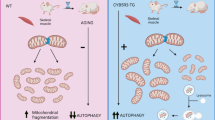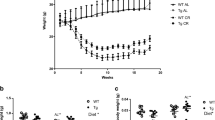Abstract
Calorie restriction (CR), a non-genetic intervention that promotes longevity in animals, may exert anti-aging effects by modulating mitochondrial function. Based on our prior mitochondrial proteome analysis, we focused on the potential roles of cytochrome c oxidase (Cox or Complex IV) subunit 6b1 on formation of mitochondrial supercomplexes comprised of Complex I, III, and IV. Blue native polyacrylamide gel electrophoresis followed by immunoblotting showed that the amount of Cox6b1 and the proportion of high molecular weight supercomplexes (SCs) comprised of Complexes I, III, and IV were increased in the liver of mice subjected to 30 % CR, compared with the liver of mice fed ad libitum. In in vitro experiments, in Cox6b1-overexpressing NIH3T3 (Cox6b1-3T3) cells, Cox6b1 was increased in the SC, III2IV1, and III2IV2 complexes and Cox was concomitantly recruited abundantly into the SC, compared with control (Con)-3T3 cells. The proportions of III2IV1, and III2IV2, relative to IV monomer were also increased in Cox6b1-3T3 cells. Cox6b1-3T3 cells showed increased oxygen consumption rates, Cox activity, and intracellular ATP concentrations, indicating enhanced mitochondrial respiration, compared with Con-3T3 cells. Despite the increased basal level of mitochondrial reactive oxygen species (ROS), cell viability after inducing oxidative stress was greater in Cox6b1-3T3 cells than in Con-3T3 cells, probably because of prompt activation of protective mechanisms, such as nuclear translocation of nuclear factor E2-related factor-2. These in vivo and in vitro studies show that Cox6b1 is involved in regulation of mitochondrial function by promoting the formation of SC, suggesting that Cox6b1 contributes to the anti-aging effects of CR.







Similar content being viewed by others
References
Baines CP, Goto M, Downey JM (1997) Oxygen radicals released during ischemic preconditioning contribute to cardioprotection in the rabbit myocardium. J Mol Cell Cardiol 29:207–216
Chen W, Gabel S, Steenbergen C, Murphy E (1995) A redox-based mechanism for cardioprotection induced by ischemic preconditioning in perfused rat heart. Circ Res 77:424–429
Civitarese AE, Carling S, Heilbronn LK, Hulver MH, Ukropcova B et al (2007) Calorie restriction increases muscle mitochondrial biogenesis in healthy humans. PLoS Med 4:e76
Colman RJ, Anderson RM, Johnson SC, Kastman EK, Kosmatka KJ et al (2009) Caloric restriction delays disease onset and mortality in rhesus monkeys. Science 325:201–204
Dani D, Shimokawa I, Komatsu T, Higami Y, Warnken U et al (2010) Modulation of oxidative phosphorylation machinery signifies a prime mode of anti-ageing mechanism of calorie restriction in male rat liver mitochondria. Biogerontology 11:321–334
Finley LW, Haigis MC (2009) The coordination of nuclear and mitochondrial communication during aging and calorie restriction. Ageing Res Rev 8:173–188
Genova ML, Lenaz G (2014) Functional role of mitochondrial respiratory supercomplexes. Biochim Biophys Acta 1837:427–443
Hancock CR, Han DH, Higashida K, Kim SH, Holloszy JO (2011) Does calorie restriction induce mitochondrial biogenesis? a reevaluation. FASEB J 25:785–791
Hayashida T, Komatsu T, Henmi Y, Yanagihara-Ota K, Kim AR, Chiba T et al (2011) Modest inhibition of the growth hormone axis does not affect mitochondrial reactive oxygen species generation or redox state, unlike calorie restriction. Geriatr Gerontol Int 11:496–503
Janssen RJ, Nijtmans LG, van den Heuvel LP, Smeitink JAM (2006) Mitochondrial complex I: structure, function and pathology. mitochondrial complex I: structure, function and pathology. J Inherit Metab Dis 29:499–515
Kadenbach B (2003) Intrinsic and extrinsic uncoupling of oxidative phosphorylation. Biochim Biophys Acta 1604:77–94
Lopez-Lluch G, Hunt N, Jones B, Zhu M, Jamieson H, Hilmer S (2006) Calorie restriction induces mitochondrial biogenesis and bioenergetic efficiency. Proc Natl Acad Sci U S A 103:1768–1773
Mair W, Dillin A (2008) Aging and survival: the genetics of life span extension by dietary restriction. Annu Rev Biochem 77:727–754
Masoro EJ (2003) Subfield history: caloric restriction, slowing aging, and extending life. Sci Aging Know Environ 2003:RE2
Massa V et al (2008) Severe infantile encephalomyopathy caused by a mutation in COX6B1, a nucleus-encoded subunit of cytochrome c oxidase. Am J Hum Genet 82:1281–1289
Mattison JA, Roth GS, Beasley TM, Tilmont EM, Handy AM et al (2012) Impact of caloric restriction on health and survival in rhesus monkeys from the NIA study. Nature 489:318–321
Miwa S, Jow H, Baty K, Johnson A, Czapiewski R, Saretzki G, Treumann A, von Zglinicki T (2014) Low abundance of the matrix arm of complex I in mitochondria predicts longevity in mice. Nat Comm 5:3837. doi:10.1038/ncomms4837
Pearson KJ, Lewis KN, Price NL, Chang JW, Perez E, Cascajo MV, Tamashiro KL et al (2008) Nrf2 mediates cancer protection but not prolongevity induced by caloric restriction. Proc Natl Acad Sci U S A 105(7):2325–2330
Ristow M, Zarse K (2010) How increased oxidative stress promotes longevity and metabolic health: the concept of mitochondrial hormesis (mitohormesis). Exp Gerontol 45:410–418
Schägger H (2001) Respiratory chain supercomplexes. IUBMB Life 52:119–128
Schägger H, Pfeiffer K (2000) Supercomplexes in the respiratory chains of yeast and mammalian mitochondria. EMBO J 19:1777–1783
Schulz TJ, Zarse K, Voigt A, Urban N, Birringer M et al (2007) Glucose restriction extends caenorhabditis elegans life span by inducing mitochondrial respiration and increasing oxidative stress. Cell Metab 6:280–293
Tsukihara T, Aoyama H, Yamashita E, Tomizaki T, Yamaguchi H (1996) The whole structure of the 13-subunit oxidized cytochrome C oxidase at 2.8 a. Science (New York, NY) 272:1136–1144
Weishaupt A, Kadenbach B (1992) Selective removal of subunit VIb increases the activity of cytochrome c oxidase. Biochemistry 31:11477–11481
Wong R, Aponte AM, Steenbergen C, Murphy E (2010) Cardioprotection leads to novel changes in the mitochondrial proteome. Am J Physiol Heart Circ Physiol 298:H75–H91
Yamaza H, Komatsu T, Wakita S, Kijogi C et al (2010) FoxO1 is involved in the antineoplastic effect of calorie restriction. Aging Cell 9(3):372–382
Yoshikawa S, Shinzawa-Itoh K, Tsukihara T (1998) Crystal structure of bovine heart cyto
Acknowledgments
We are grateful to the staff at the Laboratory Animal Center for Biomedical Research at the Center for Frontier Life Sciences, Nagasaki University for their animal care and technical assistance, and Yutaka Araki, Yuko Moriyama, Rieko Tahara, and Chika Matsumoto for their excellent technical assistance. The study was supported by Grants-in-Aid for Scientific Research from the Japan Society for the Promotion of Science (I.S., nos. 22390042) and the JSPS Asian CORE Program (I.S., nos. FY2010-5). We certify that there is no conflict of interest with any financial organization regarding the material discussed in the manuscript.
Author information
Authors and Affiliations
Corresponding author
Electronic supplementary material
Below is the link to the electronic supplementary material.
ESM 1
(DOC 4710 kb)
About this article
Cite this article
Kim, SE., Mori, R., Komatsu, T. et al. Upregulation of cytochrome c oxidase subunit 6b1 (Cox6b1) and formation of mitochondrial supercomplexes: implication of Cox6b1 in the effect of calorie restriction. AGE 37, 45 (2015). https://doi.org/10.1007/s11357-015-9787-8
Received:
Accepted:
Published:
DOI: https://doi.org/10.1007/s11357-015-9787-8




